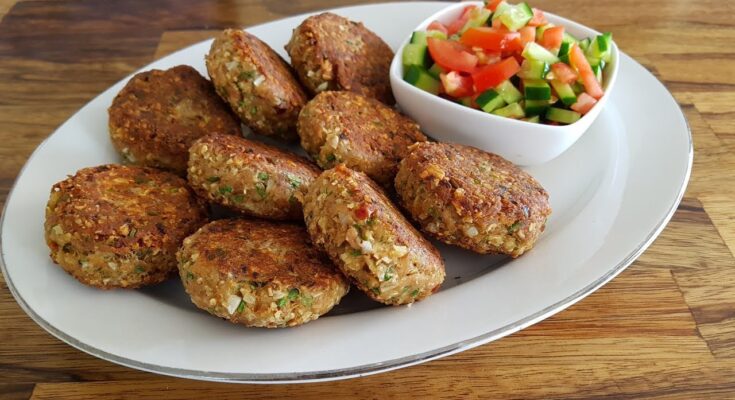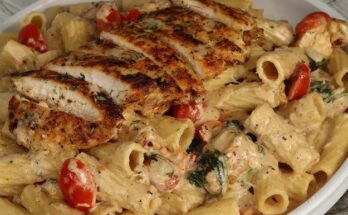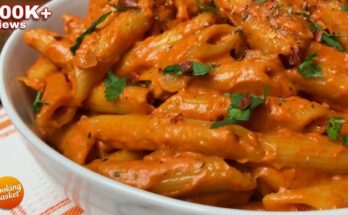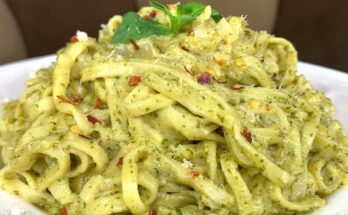Tuna Cakes Recipe: If you’re looking for a meal that’s quick, tasty, budget-friendly, and packed with protein, tuna cakes should be at the top of your list. These delicious patties are the perfect solution for busy weeknights, meal prep, or when you’re trying to whip up something satisfying using pantry staples. Plus, they’re crispy on the outside, tender on the inside, and endlessly customizable to suit your taste.
Tuna cakes, sometimes called tuna patties or tuna croquettes, are essentially mashed tuna mixed with seasonings, binders like egg and breadcrumbs, and often vegetables like onion or bell pepper. They’re then shaped into small rounds and cooked until golden brown. They strike the perfect balance between healthy and indulgent — a total win.
But beyond just flavor, tuna cakes also deliver in the nutrition department. They’re rich in omega-3 fatty acids, lean protein, and can be made low-carb or gluten-free. Whether you’re trying to eat clean, save time, or simply use up some cans of tuna in your pantry, this recipe will walk you through every step of the process — from the ingredients to serving tips and everything in between.
Ingredients You’ll Need
Crafting the perfect tuna cakes starts with the right set of ingredients. Here’s a breakdown of everything you’ll need to make flavorful, moist, and crispy tuna cakes that are sure to impress.
Canned Tuna: Choosing the Right Kind
The star of the show, obviously, is tuna. But not all canned tuna is created equal.
- Chunk Light Tuna – This is the most common and budget-friendly option. It has a softer texture, which makes it easier to mix into patties.
- Solid White Albacore Tuna – A firmer, more premium choice with a milder flavor. Great for texture but may require more mixing to break down.
- Tuna in Oil vs. Water – Tuna in water is leaner and preferred for lighter dishes. Tuna in oil adds extra richness and moisture to your cakes.
For best results, use two standard 5-ounce cans (drained) to make about 6 medium tuna cakes.
Binding Ingredients: Eggs, Mayo, and More
To hold everything together, you’ll need binders. These are essential to make sure your patties don’t fall apart during cooking.
- Eggs – One large egg per two cans of tuna should be enough.
- Breadcrumbs or Panko – About ½ cup. Panko will give a crispier texture.
- Mayonnaise – Adds moisture and richness. Use 2–3 tablespoons.
- Mustard – Optional, but a teaspoon of Dijon or yellow mustard adds a tangy depth.
Vegetables & Seasonings for Flavor
This is where you can really customize and elevate your tuna cakes:
- Chopped Onion – Red or white, sautéed or raw.
- Celery – Adds crunch and freshness.
- Bell Pepper – Sweet and colorful addition.
- Garlic – Fresh minced or garlic powder for flavor.
- Herbs – Parsley, dill, or chives for freshness.
- Spices – Salt, pepper, paprika, cayenne (if you like a little heat), and lemon zest for brightness.
Optional Ingredients for Extra Zing
If you’re feeling creative or want to boost the flavor even more, try these additions:
- Shredded Cheese – A handful of cheddar or parmesan adds richness.
- Hot Sauce – A dash of Tabasco or sriracha for heat.
- Lemon Juice – Just a splash for a zesty lift.
Now that we’ve got our ingredients lined up, it’s time to prep the tools you’ll need to make this process seamless.
Kitchen Tools and Equipment
You don’t need fancy kitchen gadgets to make tuna cakes, but having the right basic tools makes everything quicker and easier. Here’s what you’ll need:
Must-Have Tools for Making Tuna Cakes
- Mixing Bowls – At least two: one for mixing ingredients and one for dredging (if you plan to coat with breadcrumbs).
- Fork – For flaking the tuna evenly.
- Measuring Cups & Spoons – Precision matters, especially with binders.
- Non-stick Skillet or Frying Pan – Essential for a crispy crust.
- Spatula – For flipping the cakes without breaking them.
- Baking Sheet (Optional) – If you prefer to bake instead of fry.
Tips for Easy Preparation and Cleanup
- Line your baking sheet or counter with parchment paper to rest the patties before frying.
- Use gloves or lightly oil your hands when forming the cakes to prevent sticking.
- Have a paper towel-lined plate ready to drain excess oil after cooking.
Once your tools are in place, it’s time to get hands-on with the tuna itself.
How to Prepare Tuna for the Cakes
Properly prepping the tuna is one of the most overlooked but crucial steps in making sure your cakes don’t end up soggy or bland.
Draining and Flaking Tuna Correctly
Start by opening the cans of tuna and draining them thoroughly. Press the lid down into the can and tilt it to squeeze out all excess water or oil. You want the tuna as dry as possible so your cakes aren’t mushy.
Once drained, use a fork to flake the tuna into small pieces. This helps distribute it evenly throughout the mixture and ensures each bite has consistent texture and flavor.
Avoiding Common Mistakes
- Don’t leave the tuna too wet – Wet tuna = soggy patties that fall apart.
- Don’t skip the flaking step – Big chunks of tuna won’t bind as well and can create uneven patties.
- Don’t overwork the mixture – Mix just enough to combine. Overmixing can make your cakes tough.
Next up: the step-by-step process of bringing everything together and cooking up these golden beauties.
Step-by-Step Guide to Making Tuna Cakes
Here’s where the magic happens. This simple, foolproof process will give you golden, crispy tuna cakes that are moist and packed with flavor every time.
Step 1: Mix the Base Ingredients
In a large bowl, combine 2 cans of drained tuna, ½ cup of breadcrumbs, and 1 beaten egg. This forms the base structure for your tuna cakes.
Step 2: Add the Flavors and Binders
Mix in finely chopped onions, garlic, parsley, mayonnaise, and a squeeze of lemon juice. Season with salt, pepper, and a pinch of paprika or Old Bay seasoning for depth. Stir until everything comes together into a moldable mixture.
Step 3: Shape the Tuna Cakes
Form the mixture into small, even patties, about ½ inch thick. Place them on a plate and chill for 15–20 minutes to firm up.
Step 4: Cooking: Pan-Frying vs. Baking
For a crisp finish, pan-fry in a little oil over medium heat for 3–4 minutes per side. Alternatively, bake at 400°F (200°C) for 15–20 minutes until golden.
Step 5: Let Them Rest Before Serving
Transfer to a paper towel to absorb excess oil. Let rest for 5 minutes, then serve warm with tartar sauce, aioli, or lemon wedges—simple, flavorful, and protein-packed!
Serving Suggestions
Tuna cakes are super versatile when it comes to serving. Whether you’re hosting a lunch, looking for a light dinner, or making appetizers, they shine in any setting.
Sauces and Dips That Go Well
Pairing tuna cakes with a tasty dip elevates the entire experience. Here are some tried-and-true favorites:
- Tartar Sauce – The classic pairing with its creamy, tangy flavor.
- Garlic Aioli – Rich and garlicky, perfect for dipping.
- Yogurt Dill Sauce – Light and fresh, ideal if you’re going for a healthier vibe.
- Spicy Sriracha Mayo – Adds a punch for heat lovers.
You can also squeeze fresh lemon juice on top just before serving for added brightness.
Sides to Serve with Tuna Cakes
Here’s where you can get creative. Tuna cakes pair well with:
- Salads – Mixed greens with vinaigrette, cucumber salad, or coleslaw.
- Roasted Veggies – Think asparagus, zucchini, or bell peppers.
- Rice or Quinoa – Makes it a complete meal.
- Grilled Corn or Sweet Potato Fries – For something heartier.
Want to serve them sandwich-style? Pop a tuna cake between two slices of crusty bread or a soft brioche bun with lettuce, tomato, and your favorite sauce. Instant tuna burger!
Storage and Reheating Tips
Got leftovers? Tuna cakes store beautifully and reheat well, making them a perfect choice for meal prep or next-day lunches. But you have to do it right to preserve their texture and flavor.
How to Store Tuna Cakes Properly
Once your tuna cakes are fully cooked and cooled to room temperature:
- Refrigerate: Place them in an airtight container with layers separated by parchment or wax paper. This prevents them from sticking together.
- Shelf Life: They’ll stay fresh in the fridge for up to 3–4 days.
If you want to store them for longer:
- Freeze: Wrap each cake individually in plastic wrap or foil, then place them in a freezer-safe bag or container.
- Freezer Life: Properly stored, they can last for up to 2 months.
Pro Tip: Label containers with the date so you don’t forget how long they’ve been in there.
Best Reheating Methods
Reheating tuna cakes is all about keeping them crisp outside while warming the inside without drying them out.
- Oven or Toaster Oven: Preheat to 375°F (190°C) and bake for 8–10 minutes. This method keeps them crispy.
- Stovetop: Heat a small amount of oil in a pan and reheat over medium heat for 3–4 minutes per side.
- Microwave: Fast but not ideal. Use medium power for about 1 minute. The texture may get soft, so pair it with a quick sear in a pan afterward if you prefer crunch.
- Air Fryer: Reheat at 350°F (175°C) for 5–6 minutes. A great way to bring back that just-cooked crispness.
Whichever method you choose, make sure the cakes are heated all the way through before serving.
Variations and Substitutions
Tuna cakes are endlessly customizable. You can tweak them based on your diet, preferences, or whatever’s in your fridge.
Gluten-Free or Keto Alternatives
Want to ditch the breadcrumbs? No problem.
- Almond Flour: A great low-carb, keto-friendly substitute that adds nutty flavor.
- Coconut Flour: Absorbs moisture well, but use sparingly (it’s more absorbent).
- Crushed Pork Rinds: Perfect for a crunchy, zero-carb binder.
For gluten-free folks:
- Gluten-Free Breadcrumbs or Oats: Simple 1:1 substitution.
- Chickpea Flour or Cornmeal: Adds a bit of earthiness and holds up well.
Just keep an eye on moisture. If the cakes seem too wet, add more of your dry binder in small increments.
Using Fresh Tuna Instead of Canned
If you have leftover grilled or poached tuna, you can absolutely use it.
- Chop or shred the tuna finely before mixing.
- You may need to add a touch more mayo or egg since fresh tuna can be drier than canned.
- The flavor is fresher and more delicate, so balance it with bold seasonings or sauces.
Vegetarian or Vegan Versions
Want a plant-based twist?
- Swap tuna for mashed chickpeas or jackfruit.
- Use vegan mayo and flaxseed egg (1 tbsp flaxseed + 3 tbsp water) as a binder.
- Add bold spices and herbs to make up for the missing fishy flavor.
These tweaks make the recipe incredibly inclusive and adaptable for any diet.
Common Mistakes to Avoid
Even a simple recipe like tuna cakes can go wrong if you’re not careful. Here are the top mistakes to steer clear of — and how to fix them.
1. Overmixing the Ingredients
This is a common issue that leads to dense, tough patties.
- Fix: Mix just until combined. It’s okay if it looks a bit rustic.
2. Skimping on Seasoning
Tuna is mild and needs help from spices, herbs, and acid to shine.
- Fix: Be generous with salt, pepper, lemon juice, garlic, and herbs.
3. Using Too Much or Too Little Binder
If your cakes fall apart, it’s likely a binding issue.
- Fix: Ensure the mix has enough egg and dry binder like breadcrumbs. Let it rest to absorb moisture before shaping.
4. Not Draining the Tuna Well Enough
This leads to wet, mushy cakes that don’t hold their shape.
- Fix: Press the tuna dry with the lid or use paper towels to wick away moisture.
5. Overcrowding the Pan
Trying to cook too many at once makes them steam instead of crisp.
- Fix: Cook in batches and give each patty room to breathe in the pan.
6. Cooking at the Wrong Temperature
Too hot and the outside burns before the inside cooks. Too low and they get soggy.
- Fix: Medium heat is your friend. Test with one cake first if unsure.
Master these pitfalls and you’ll have restaurant-worthy tuna cakes every time.
Nutritional Information
Let’s talk numbers. Tuna cakes aren’t just tasty—they can be a solid part of a balanced diet too.
Standard Nutritional Breakdown (Per Medium Tuna Cake)
| Nutrient | Approx. Value |
|---|---|
| Calories | 180–220 |
| Protein | 18–22g |
| Carbohydrates | 6–10g |
| Fats | 10–12g |
| Fiber | 1–2g |
| Sodium | 300–400mg |
Health Highlights
- High in Protein: Great for muscle building and satiety.
- Omega-3s: Heart-healthy fats from tuna.
- Low in Sugar: Naturally low-sugar, especially without sweet sauces.
- Customizable for Diets: Can be made gluten-free, keto, dairy-free, etc.
Just be mindful of the sodium if you’re using canned tuna — rinse it beforehand if needed, or opt for low-sodium varieties.
Budget-Friendly Tips
One of the best things about tuna cakes is how affordable they are. With a few smart swaps and strategies, you can enjoy this dish regularly without breaking the bank.
Saving Money with Pantry Staples
Tuna cakes are practically made for budget cooking. Most ingredients are already sitting in your pantry or fridge:
- Canned Tuna – Often under $1 per can when bought in bulk.
- Breadcrumbs – Make your own from leftover bread or use oats.
- Eggs and Mayo – Staples in nearly every fridge.
- Veggies – Use up that half onion or aging celery before it goes bad.
If you’re low on fresh veggies, don’t worry. Frozen chopped onions or bell peppers work just as well. Even dried herbs and spices can pack a flavor punch when fresh isn’t an option.
Bulk Cooking and Freezing Options
Tuna cakes are perfect for batch cooking. Double or triple the recipe on a Sunday, and you’ve got lunch or dinner sorted for the whole week.
- Make Ahead: Shape and store uncooked patties in the fridge for up to 24 hours.
- Freeze Raw or Cooked: Freeze raw patties separated by parchment, or freeze cooked ones to reheat later.
- Reheat in Minutes: Pull them from the freezer and cook directly in a pan or oven — no defrosting needed!
Buying canned tuna in bulk packs or from wholesale stores also helps reduce per-serving costs. It’s a smart way to meal prep on a tight budget while still eating something satisfying and healthy.
Tuna Cakes for Kids
Feeding picky eaters? Tuna cakes can be a hit with kids when prepared thoughtfully. The key is to make them fun, mild, and maybe a little sneaky when it comes to the veggies.
Making It Kid-Friendly
- Use Mild Tuna: Go for chunk light tuna in water for a milder flavor.
- Minimize the Veggies or Chop Them Finely: Kids might not love chunks of onions or peppers, so dice them super small or sauté them to soften.
- Skip the Spicy Stuff: Leave out cayenne or strong herbs. Stick to simple seasoning like salt, pepper, and garlic powder.
- Add Cheese: A bit of shredded cheddar or mozzarella makes the patties more appealing and creamy.
Fun Shapes and Mild Flavors
Kids eat with their eyes first. Use cookie cutters to shape the patties into stars, hearts, or animals. It sounds silly, but it works.
You can also serve them with fun dipping sauces like:
- Ketchup (yes, it’s weird — but kids love it!)
- Ranch dressing
- Mild honey mustard
Serve them in mini slider buns or with mac and cheese for a comfort food combo that pleases even the pickiest palettes.
Pairing Tuna Cakes with Beverages
Pairing your meal with the right drink can elevate a simple dish like tuna cakes into a full-on dining experience — even if you’re just eating at home on a Tuesday night.
Wine Pairings
Tuna is a light fish, so you want to match it with crisp, refreshing wines:
- Sauvignon Blanc – Crisp and citrusy, a perfect match.
- Pinot Grigio – Light, dry, and subtle enough to let the flavors shine.
- Chardonnay – Especially unoaked varieties, which complement creamy sauces.
For those who enjoy sparkling wines:
- Prosecco or Cava – Bubbly adds a celebratory feel and cuts through the richness.
Non-Alcoholic Options
- Sparkling Water with Lemon – Simple, fresh, and palate-cleansing.
- Iced Tea with Herbs – Think mint, lemon, or ginger.
- Citrus Mocktails – Lime, grapefruit, or orange juice mixed with soda water and herbs.
Kids? Serve tuna cakes with a fruit smoothie or even a little apple juice spritzer for a fun, wholesome drink.
FAQs about Tuna Cakes Recipe
1. Can I use flavored canned tuna?
Yes! Flavored tuna varieties like lemon pepper or spicy Thai can add a unique twist. Just be mindful of the salt and seasoning levels — you may need to adjust the recipe accordingly.
2. How long do tuna cakes last in the fridge?
Cooked tuna cakes can last 3–4 days in the fridge if stored in an airtight container. Reheat before serving to revive the texture.
3. What’s the best binder for tuna cakes?
Eggs and breadcrumbs are classic, but you can use mashed potatoes, crushed crackers, or even chia seeds for binding. Just ensure the mixture is firm enough to hold shape.
4. Can I make these in an air fryer?
Absolutely! Air frying gives them a crisp texture with less oil. Cook at 375°F (190°C) for 8–10 minutes, flipping halfway through.
5. How do I prevent tuna cakes from falling apart?
Make sure your tuna is well-drained, the mixture is not too wet, and you’ve added enough binder (egg + breadcrumbs). Let them rest in the fridge for 10–15 minutes before cooking.
Conclusion
Tuna cakes are one of those unsung heroes in the world of home cooking — simple, satisfying, and surprisingly flexible. With pantry staples, a little creativity, and less than 30 minutes, you can whip up a batch of golden, flavorful patties that check all the boxes: protein-packed, budget-friendly, family-approved, and downright delicious.
Whether you’re eating them hot from the pan with a crispy crust, tucked inside a sandwich, or prepped ahead for busy lunches, tuna cakes are an easy win in any kitchen. Now that you’ve got the full blueprint — ingredients, method, tips, and more — there’s nothing stopping you from making the best tuna cakes of your life.



